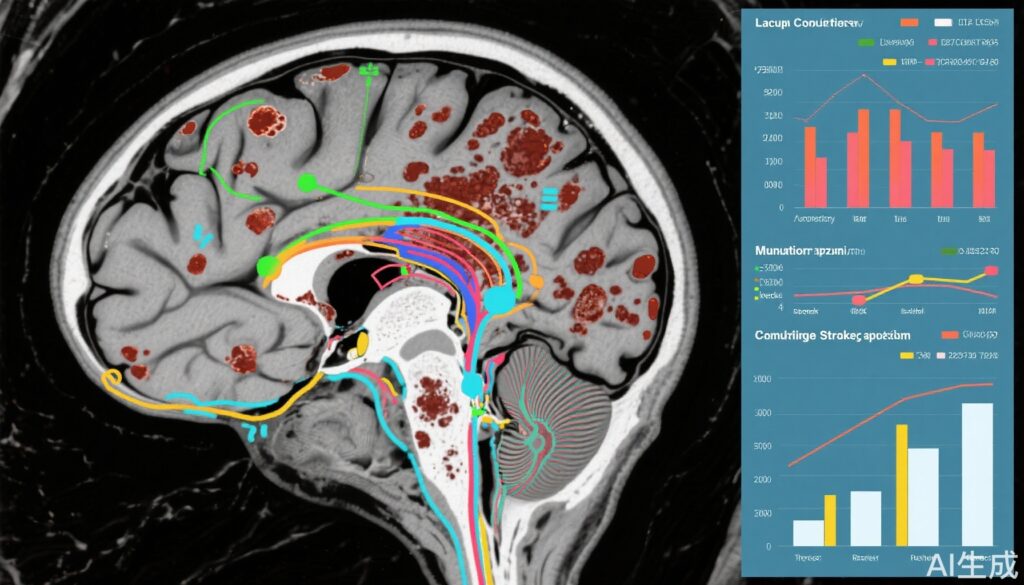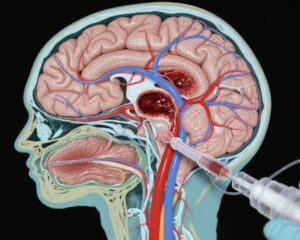Study Background and Disease Burden
Minor ischemic strokes, including lacunar and mild cortical subtypes, often present with subtle neurological deficits that are nondisabling initially. Despite their seemingly mild clinical presentations, these stroke subtypes contribute significantly to long-term morbidity, including cognitive decline, repeated vascular events, disability, and increased mortality rates. Lacunar strokes arise primarily from cerebral small vessel disease (SVD), whereas cortical strokes generally involve larger cortical arteries. Distinguishing long-term outcomes between these stroke types is critical to understanding SVD pathophysiology, prognostication, and tailoring secondary prevention. However, data on extended follow-up, especially beyond five years, remain limited and inconclusive, impeding informed clinical decision-making. The study by Garcia et al. provides valuable insights by examining up to 9 years of outcomes among patients with minor lacunar and cortical ischemic strokes recruited in Edinburgh, UK.
Study Design
This prospective, longitudinal observational cohort study enrolled 264 participants presenting with mild, nondisabling ischemic stroke (lacunar or cortical) from the Lothian Stroke Services. Baseline data included sociodemographic characteristics, vascular risk profiles, dependence status, cognitive function, and detailed brain magnetic resonance imaging (MRI), including white matter hyperintensities assessments. Follow-up at approximately 9 years utilized structured questionnaires, including components of the Stroke Impact Scale, and retrospective review of hospital and general practitioner (GP) records. Key endpoints included diagnoses of dementia, recurrent stroke incidence, mortality, vascular events such as cardiac conditions, ongoing vascular risk factors, levels of dependence, recovery, and functional status.
Key Findings
Among the 264 recruited participants, clinical data were available for 243 (92%) with a baseline mean age of 67 years (SD 12), 42% female, and 44% diagnosed with lacunar stroke. Functional self-reported data were obtained for 96 individuals (36%) at a mean of 8.5 years follow-up.
Dementia incidence was 9.4% in lacunar stroke patients and 12.4% in cortical stroke patients. Importantly, older age significantly increased dementia risk (odds ratio [OR] 1.08; 95% confidence interval [CI] 1.030–1.130). Recurrent stroke occurred in approximately one-third of participants, with vascular risk factors markedly elevating recurrence risk (OR 2.27; CI 1.287–4.032). Mortality was higher among cortical stroke patients compared to lacunar stroke patients (χ2 = 8.2; p = 0.004). Independent risk factors for death included older age (OR 1.09; CI 1.051–1.133), male sex (female OR 0.40; CI 0.196–0.818), and presence of white matter hyperintensities seen on MRI (OR 1.36; CI 1.112–1.664).
Moderate to severe disability was reported by 12% of participants, while cognitive concerns were prevalent, reported by 49%–55%. Surprisingly, limb recovery and balance deficits were more pronounced in those with lacunar stroke (W = 705.5, p = 0.00), suggesting persistent motor and proprioceptive impairments distinctive to small vessel disease pathology.
Figure 3. Kaplan-Meier Survival Curves Comparing Death Rates Between Cortical and Lacunar Stroke at 9 Years After Stroke (n = 143).

These results highlight that even mild strokes carry a substantial burden of long-term cognitive impairment, physical disability, recurrent cerebrovascular events, and increased mortality. Differences by stroke subtype may reflect divergent underlying vascular pathologies and mechanisms influencing recovery trajectories and prognosis.
Expert Commentary
This landmark 9-year follow-up study addresses a gap in understanding long-term outcomes after minor stroke, particularly lacunar stroke, which is often overlooked in clinical practice due to mild initial presentations. The finding that dementia risk and vascular events remain substantial years later underscores the importance of diligent long-term monitoring and aggressive management of vascular risk factors. The elevated mortality risk associated with cortical stroke aligns with more extensive cortical involvement and possibly larger infarct volumes.
The association of white matter hyperintensities with death and cognitive decline reinforces the critical role of SVD in adverse outcomes. Worse motor and balance recovery in lacunar stroke cases may reflect the subcortical localization and involvement of motor pathways susceptible to microvascular injury.
Limitations include potential selection bias given the single geographic center and partial self-reported functional data completeness, which could underestimate disability. Nonetheless, the robust clinical and imaging characterization and extended follow-up duration lend strong clinical relevance.
Future research should investigate therapeutic strategies targeting SVD progression and cognitive preservation in lacunar stroke, as well as tailored rehabilitation approaches addressing balance and motor deficits unique to this subgroup.
Conclusion
Long-term follow-up reveals that both lacunar and mild cortical ischemic strokes lead to considerable functional, cognitive, and vascular morbidities up to a decade post-event. Dementia and recurrent strokes are common, with subtype-specific differences in mortality and motor recovery. These findings highlight lacunar stroke not as a benign entity but a condition requiring sustained clinical vigilance and intervention to improve patient quality of life and survival.
Optimizing secondary prevention, comprehensive rehabilitation, and cognitive monitoring remain urgent priorities. The study’s insights should inform clinical guidelines and stimulate research into mechanisms and therapies to mitigate the enduring impact of minor ischemic strokes.
References
Garcia DJ, Makin SDJ, McHutchison CA, Cvoro V, Valdés Hernández MDC, Sakka E, Chappell FM, Doubal F, Wardlaw JM. Functional, Cognitive, Physical, and Vascular Outcomes 9 Years After Lacunar and Mild Cortical Ischemic Stroke. Neurology. 2025 Sep 9;105(5):e214018. doi: 10.1212/WNL.0000000000214018 IF: 8.5 Q1 . Epub 2025 Aug 20. PMID: 40834341 IF: 8.5 Q1 ; PMCID: PMC12367423 IF: 8.5 Q1 .



